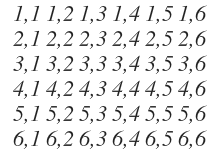Insane Dice
You roll two 1,000 sided dice(with sides numbered 1 to 1,000) and add both outcomes. What sum are you must likely to get? (Assume both die are fair and don't think too hard about how you got two 1,000 sided dice).
The answer is 1001.
This section requires Javascript.
You are seeing this because something didn't load right. We suggest you, (a) try
refreshing the page, (b) enabling javascript if it is disabled on your browser and,
finally, (c)
loading the
non-javascript version of this page
. We're sorry about the hassle.
3 solutions
Play with the dice and you can get it, I mean..
Just THINK.
Fix any no., n in the first dice now spin the other dice
for all outcomes on the 2 n d dice i.e. from 1 to 1000
the range of the sum is [ ( n + 1 ) , ( 1 0 0 0 + n ) ] . Given this f a c t a slightly curious detective look on it will reveal that the no. 1 0 0 1 appears in all the ranges of sum.
Making it the most favourable suspect.... If you like this do an extra favour of liking me.
If you don't get it write back ..
ARYA . :)
Hey, you will get the same number of outcomes for 1000 as sum as 1001 as sum or what I am saying is that 1000 could also be that answer because the outcomes for two consecutive numbers such that the smaller number is even and the larger is odd , exception as 1 , 2 and 3 , is the same.
Log in to reply
Well I think you just a missed to eye on the case when
the first dice turns up to be 1000 , then for whatever no. on the other dice the sum will be more than 1000. Agree?
Log in to reply
A hmm.., I think you are right but please can you explain me your point.
Log in to reply
@Utkarsh Dwivedi – I believe that what he's saying is that if you select the first die to be 1000, and is no number you can choose on the second die for which the sum will be 1000. So 1001 occurs 1000 times (you can select all 1000 numbers on the first die) but 1000 occurs only 999 times, because you can't select 1000 for the first die. Got it?
i didnt get it
Why am I getting a bbc sherlock vibe from you?
Log in to reply
I think you were talking about Arya, but I'm going to pretend you were talking about me, so thanks.
The sample space of two dice throws is represented in the array. The diagonal lines(bottom left to top right) have the same sum. The longest diagonal is the one with most number of outcomes(largest number of pairs). It always starts from the last entry in the first column and ends in the last entry of first row. The same logic will be applied on a 1000*1000 array. The bottom and leftmost entry has sum 1001 (pair is 1000,1)

Yeah. that's sort of how I got the idea for the problem :)
Let's view this from the opposite. What sums are most unlikely to get? Those are 2 and 2000. Why? The smallest number on both dices is 1 and the largest is 1000 and 1 + 1 = 2 and 1 0 0 0 + 1 0 0 0 = 2 0 0 0 . And it's impossible to form another sum of 2 and 2000 with those dices, because for that you needed a side smaller than 1 and greater than 1000. But you simply don't have such things. The most possibilities to form a sum must be at the middle between 2 and 2000:
2 2 + 2 0 0 0 = 1 0 0 1